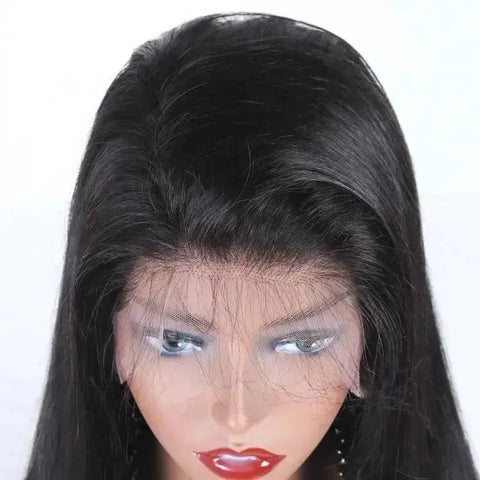Most people when starting out with early stages of hair thinning, hair loss, or alopecia opt for a silk top hair topper because it is the easiest to blend and has the most realistic hairline. Silk top hair toppers are best for women with hair loss who have a stronger hairline and their hair loss is concentrated at their parting and crown.
If your hair loss is more noticeable at your hairline, you may want to opt for a lace front hair topper or wig, as traditional silk top hair toppers require your own hair to blend a natural hairline and hide the transition between the topper and your natural hair. A lace front or lace top hair topper or wig comes with a natural looking hairline, which won't require any blending, but may require some taping or gluing down.
If you are at a more advanced stage of hair loss or completely bald, you will likely want to opt for a wig. Many wigs have comfort cap constructions intended for medical hair loss with softer materials and silicone linings.

How do I choose a hair topper or wig?
Honestly (and this isn't a cop-out answer), there isn't a "right" answer—many people can wear and look great in both wigs and hair toppers!
In many instances, it comes down to personal preference and it may even be dependent on the occasion or weather as well. Here is everything you need to know about wigs and hair toppers to help you make the right choice for you.
But first, what is the difference? What is a wig vs. hair topper?
A wig is a hair piece that covers your entire head of hair.
Wigs allow you to wear a hair piece that is different from your natural hair color and wigs also provide more full coverage for your scalp. Wigs are ideal for women with advanced stages of hair loss or women who are bald.
You can wear most wigs without any clips, which you may consider if you don't like clips or you have a sensitive scalp. Some women feel that the clips in hair toppers can cause traction hair loss, which pushes them to opt for wigs instead.
A hair topper covers just the top of your head and adds volume and density to your own hair.
You might think of a hair topper as a push-up bra for your hair! Hair toppers are essentially clip-in hair extensions that have an additional area covering the top of your head. Hair toppers are perfect for women with hair loss concentrated at their crown and parting.

Hair toppers are lighter and less dense compared to wigs - they provide partial coverage for women who have early to advanced stages of hair loss.
What factors should I consider when deciding whether a wig or topper is right for me?
Here are some things to consider:
1. Does your hair match the color of the hair piece?
As mentioned above, if you plan to wear a hair piece that is more than one shade darker or lighter in color than your natural hair, it is usually best to shop for a wig. You may be able to blend slight differences (e.g. you can wear a dark brown topper with black hair), but if you want it to look at natural as possible, wigs are recommended.

In addition, if you have curly hair and don't want to style your natural hair every day (which, let's face it, is a big pro of wearing hair pieces!), wigs are probably more suitable. Most hair toppers usually dry straight or slightly wavy, which may not blend as well with natural hair that has more texture.
2. What time of year is better for your hair piece?
Because wigs cover more of your head and tend to have higher hair density, they are definitely hotter than hair toppers! Many women choose to wear hair toppers in the summertime and save their wigs for cooler weather.

If you live in a hotter climate, you may want to opt for a hair topper or lower density wig. If you are looking for a wig that will be a little cooler, you may consider a lace wig versus a silk top because there is less material in the cap construction!
3. How do you feel about hair pieces that require clips?
Hair toppers are typically fastened onto your head with clips (similar to clip-in hair extensions). Some women may find this irritating or painful, especially if they have a sensitive or oily scalp, or more overall thinning hair.
How do hair toppers stay on?
Usually toppers are held securely in place with pressure snap clips. However, they can also be semi permanently attached using bonding and hair extension techniques. There are also some options unique to Hair Necessity that can be removed daily AND do not require attachment to your growing hair.
What is better a wig or a topper?
Because wigs cover more of your head and tend to have higher hair density, they are definitely hotter than hair toppers! Many women choose to wear hair toppers in the summertime and save their wigs for cooler weather. If you live in a hotter climate, you may want to opt for a hair topper or lower density wig.
To find the best hair topper, we have to learn what it means to be the "best." There are a lot of factors to consider, and the best hair topper will vary from woman to woman. However, there are some things that are universal important when you're searching for the best topper:
1. Coverage Type:
Coverage is one of the most important things to consider when searching for your topper. After all, coverage is the main reason women buy toppers.
2. Texture & Hair Type:
When you're looking for your topper, you should always take hair texture into consideration. Try to find a hair topper with a similar texture to your own hair for the most realistic look. 
3. Hair Color
The closer the color of your hair topper matches the color of your hair, the more realistic it will look. Visit our wig color guide here, or consult with our wig expert via email to help you find the best color match for your hair topper.
Human hair toppers are definitely recommended because it offers more versatility such as dying or bleaching the hair, styling with hot tools, and durability. One of the best features of a human hair topper is that it doesn't get hot compared to wearing a wig.










